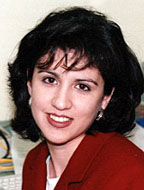 Prepared by
Prepared by
Melissa Brener, MS
Page 3 of 4
Planning your menus ahead of time
and shopping for what you need can save you both money and time,
while helping to stretch your food dollar.
|
|
Click here for the printable (Word) version of the lesson
Use What You've Learned!
- 1. Practice planning a three-day menu for your family that
includes breakfast, lunch, dinner and a snack. Make sure that
the menu for each whole day includes at least two servings of
meat, two servings of dairy foods, two servings of fruit, three
servings of vegetables and six servings of breads and grains.
Make a shopping list, purchase the foods on your list and actually
use the menus for three days in a row. Is it easier to prepare
meals when you know what you'll serve and have all the ingredients
on hand?
2. Practice using correct serving sizes when you eat. Measure
your portions using measuring cups or weighing food if you have
a scale so that you will know what a portion should look like.
Are these the portion sizes you normally eat?
- If you are trying to lose or maintain your weight, this might
help you!
3. Explain how the Food Guide Pyramid works to someone else.
This will help you understand it even better.
4. Use the Thrifty Food Plan to plan nutritious meals within
a modest budget. The lesson "Managing
Your Food Dollar" includes more information on the Thrifty
Food Plan, 1999.
Web
Site Activities
www.familyfoodzone.com
www.got-milk.com
www.mealsforyou.com/mfy/
Allows you to plan a menu, provides all the recipes and even
gives you a shopping list that corresponds to a store near you.
Also do a nutrient analysis of the meal, so you'll know
how much fat, dietary fiber, vitamins and minerals you're getting.
How
Much is a Serving?
Breads and Grains
- One slice of bread
- One-half hamburger or hot dog bun, bagel, English muffin
- One roll, muffin or biscuit
- Four to six crackers
- One-half cup cooked cereal
- One ounce (three-fourths to one cup) ready–to–eat
cereal
Vegetables
- One-half cup cooked vegetables
- One cup green leafy vegetables
- One-half cup raw chopped vegetables
- Three-fourths cup vegetable juice
Fruits
- One medium piece of fruit (apple, banana, orange)
- One-half cup berries
- One-half cup canned, chopped or cooked fruit
- Three-fourths cup fruit juice
- One-fourth cup dry fruit (raisins)
Dairy
- One cup milk
- Eight ounces yogurt
- One and one-half ounces cheese
Meats or Meat Alternates
- Two to three ounces meat, poultry or fish (without skin)
- One egg
- One-half cup cooked dry beans
- Two tablespoons peanut butter
Summary
Food is made of six different nutrients. Carbohydrate,
protein and fat are called macronutrients. Vitamins and minerals
are called micronutrients. Water is also a nutrient, in a class
by itself. The Food Guide Pyramid can help you plan healthy meals
for you and your family. The Pyramid is made up of six food groups.
You should eat foods from each group every day.
The key to healthy eating is balance, variety and moderation:
Eat a balanced meal with a variety of foods, but remember to
eat in moderation (not too much fat and sugar!).
Planning your menus ahead of time and shopping for what you
need can save you both money and time, while helping to stretch
your food dollar.
   [ LESSONS || SITE
MAP || LOCAL AGENTS || RESOURCES || PEOPLE ]
[ LESSONS || SITE
MAP || LOCAL AGENTS || RESOURCES || PEOPLE ]
 Issued in furtherance of Cooperative Extension
work, Acts of Congress of May 8 and June 30, 1914, in cooperation
with the United States Department of Agriculture. The Louisiana
Cooperative Extension Service provides equal opportunities in
programs and employment. Information and Graphics on this site
are copyright protected by LSU Agricultural Center's Louisiana Cooperative Extension Services.
For more information
on the EFNEP program, contact EFNEPMail@agcenter.lsu.edu. Issued in furtherance of Cooperative Extension
work, Acts of Congress of May 8 and June 30, 1914, in cooperation
with the United States Department of Agriculture. The Louisiana
Cooperative Extension Service provides equal opportunities in
programs and employment. Information and Graphics on this site
are copyright protected by LSU Agricultural Center's Louisiana Cooperative Extension Services.
For more information
on the EFNEP program, contact EFNEPMail@agcenter.lsu.edu.
|